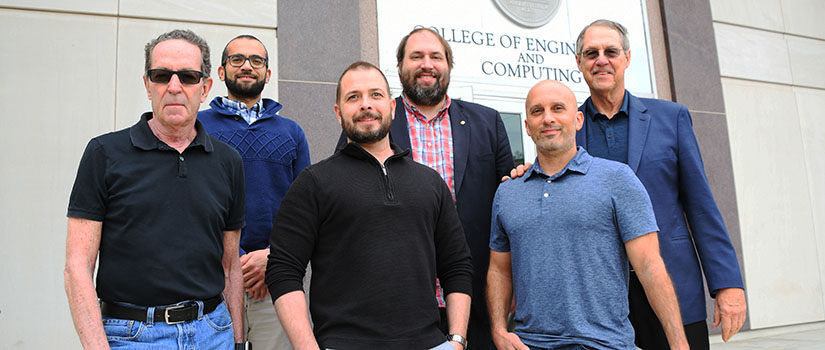Pictured Above: USC Center for Acute Stress and Credibility Assessment team
Front Row (L-R): Clinton Webb, Nicholas Boltin, Tarek Shazly
Back Row: (L-R): Ahmed Alshareef, Mark Uline, Michael Sutton
A traditional polygraph test analyzes human physiological responses through sensors measuring several biometric parameters, such as blood pressure and pulse rate, which are monitored during an interview.
A contactless polygraph process is an advancing technology with many benefits over the traditional methods. The College of Engineering and Computing (CEC) is now home to a new center that will focus on high-tech, non-invasive technology for polygraphs and credibility assessment.
“We’re very excited to partner with everyone that can provide input on ways of enhancing credibility assessment and contribute to this important area of research and national security.
- Mark Uline
The Defense University Research Instrumentation Program (DURIP) is providing $1.3 million to purchase thermal and optical imaging equipment for the University of South Carolina Biomedical Engineering Center for Acute Stress and Credibility Assessment, which will be located at the CEC. Sponsored by the U.S. Air Force, Air Force Office of Scientific Research and Department of Defense (DoD), Department of Biomedical Engineering Chair Mark Uline will be the lead in the center’s development. Also involved in the project will be Ahmed Alshareef, Tarek Shazly and Michael Sutton (mechanical/biomedical engineering), Nicholas Boltin (biomedical engineering), and Clinton Webb (biomedical engineering/medicine).
Michael Matthews, associate vice president for research and national laboratory relations, and vice dean for the CEC, and Admiral Paul Gaffney, counselor to Dean Hossein Haj-Hariri, began an initiative earlier this year to facilitate interactions with the DoD.
During one of the meetings, discussions focused on how the DURIP could facilitate the university’s work to advance contactless polygraph. Unlike a traditional lie detection (credibility assessment) test, advanced contactless polygraph uses thermal and optical imaging to capture in-time biometric measures of an interviewee caused by changes in heart rate and blood pressure to detect lying.
“They [the DoD] saw our skill set in doing blood pressure measurements and connected us with our program officer in the Air Force, who decided to fund the center. I didn’t expect this to be funded so quickly, but I think the program officer was impressed with our capabilities after meeting with our team,” Uline says. “Also, the creation of the Biomedical Engineering Center for Acute Stress and Credibility Assessment was seen as a tremendous value-added approach to the development of new technology for measuring the physiological responses in a polygraph, thus providing advanced technological support to certain areas within the DoD.”
The DURIP grant will provide equipment for the lab. The work will be an extension of existing research at the CEC and USC School of Medicine and lead to projects funded through different agencies of the DoD.
“This center will be a vital addition to our mission of serving the needs of the state and the nation. There are many situations, such as health care and law enforcement, where it is important to quickly determine whether a person is under physical, mental or emotional stress,” Matthews says. “The center will be equipped with state-of-the-art, non-intrusive technology for quickly measuring heart rate and other physical indicators.”
“There's a backlog of people waiting years who need to be interviewed with polygraphs for getting security clearances from the DoD,” Uline says. “Contactless biometric measures would help make the process quicker and less intrusive.”
According to Uline, it has been established that some facial regions change in temperature during stressful situations and beat-by-beat blood pressure can be tracked through these changes. The center’s equipment will be utilized for highly innovative thermal imaging techniques. When the center opens, USC will be one of a few facilities in the country with this type of thermal imaging measurement capabilities.
“You have to be focused on certain areas of the face to see these thermal signatures, and we're trying to do it on the time scale on the order of a heartbeat because that's what’s needed for lie detection,” Uline says. “People sit and answer questions with cameras on them, which has several benefits over a traditional polygraph used by law enforcement.”
While credibility assessment is the primary application of the center’s research, projects involving acute stress will also be performed. Boltin is currently working with Prisma Health in measuring the stress of clinicians during their shifts.
“He [Boltin] measures biometrics and how long it takes clinicians to return to baseline after very stressful interactions. The military might be interested in using this type of technology for people in the field to see how they react,” Uline says.
The researchers involved with the center bring expertise in imaging and physiology. “The DURIP grant will enable research in an area of immediate need as identified by the agencies overseeing credibility assessment. It will also provide equipment to support advanced imaging and imagine analysis that can be applied to ongoing and future research projects in biomedical engineering,” Shazly says.
Uline is excited that the center will provide a channel for military research within the CEC and for generating funds and projects for the entire university to utilize. There are also many educational and workforce development applications being developed associated with the new center.
“We’re very excited to partner with everyone that can provide input on ways of enhancing credibility assessment and contribute to this important area of research and national security,” Uline says.
